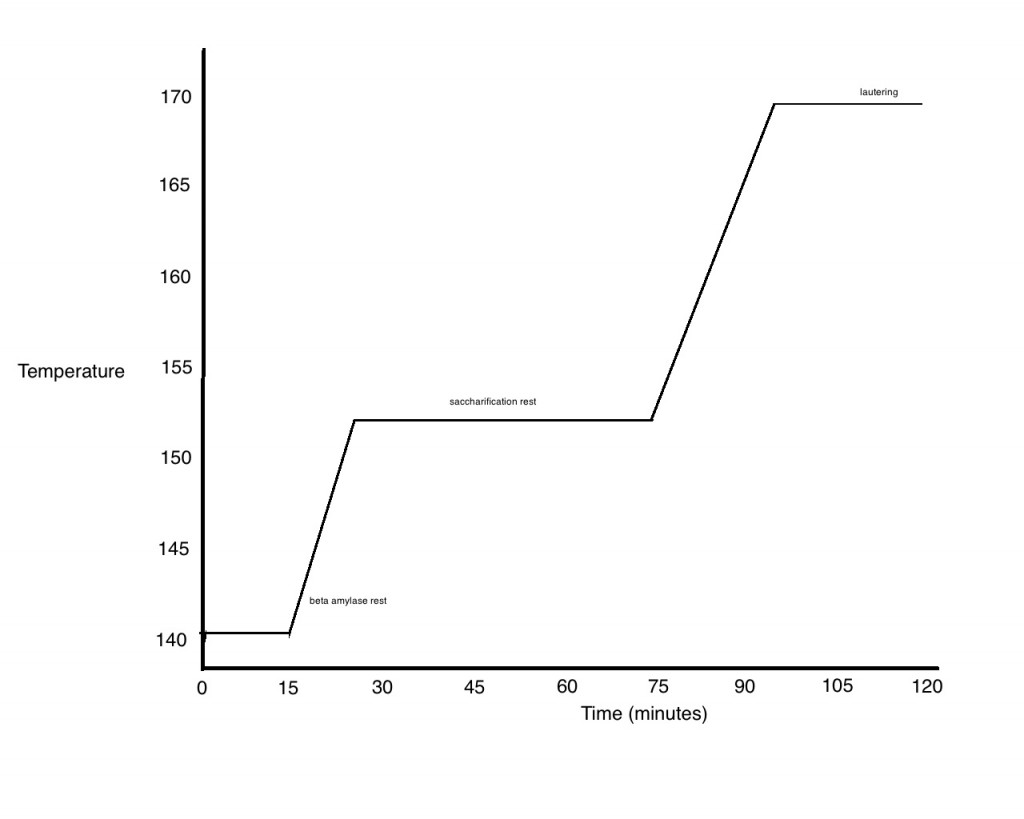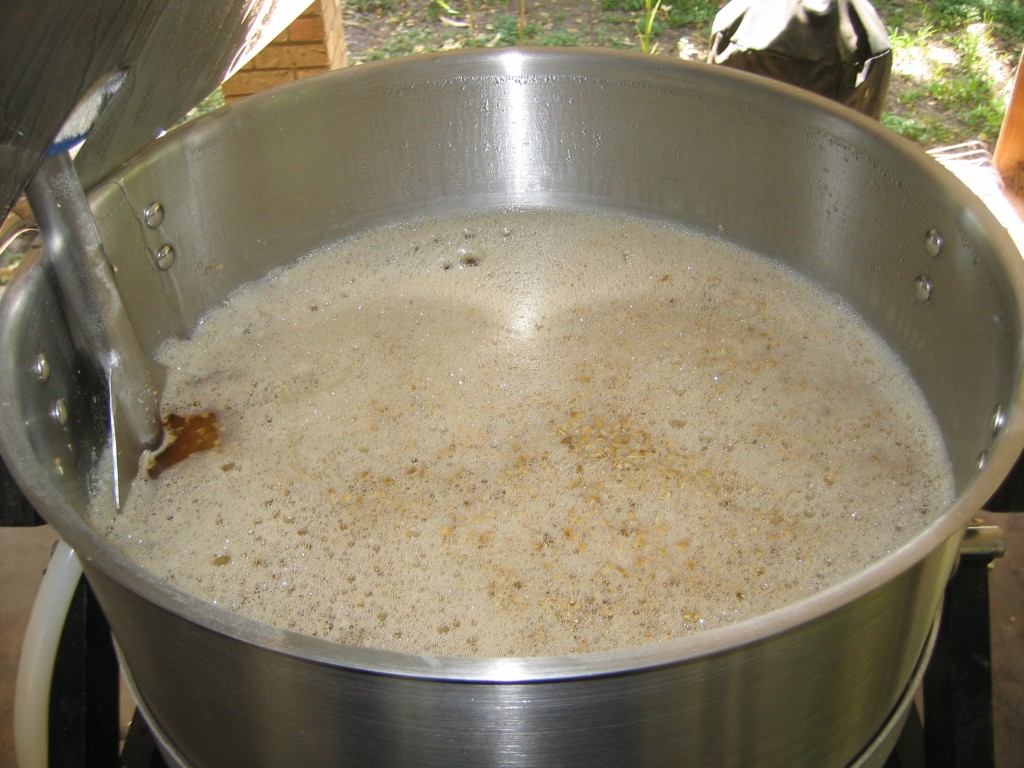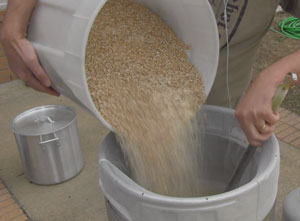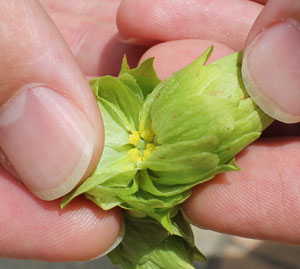 Partial mashing is a method of wort production in which the brewer produces some of his wort from a mash — as an all-grain brewer would do — but supplements it with malt extract. In practice, it is usually used in conjunction with a partial wort boil, so that it is similar to the common malt-extract-plus-steeping-grains method. For extract brewers who don’t have the space for a full all-grain set-up, or outdoor all-grain brewers who occasionally wish to come in from the heat or cold, it is method of brewing that is more flexible — and I would argue produces higher quality beer — than the normal malt-extract-plus-steeping-grains methods. [Read more…]
Partial mashing is a method of wort production in which the brewer produces some of his wort from a mash — as an all-grain brewer would do — but supplements it with malt extract. In practice, it is usually used in conjunction with a partial wort boil, so that it is similar to the common malt-extract-plus-steeping-grains method. For extract brewers who don’t have the space for a full all-grain set-up, or outdoor all-grain brewers who occasionally wish to come in from the heat or cold, it is method of brewing that is more flexible — and I would argue produces higher quality beer — than the normal malt-extract-plus-steeping-grains methods. [Read more…]
Partial Mash Option (and ESB Recipe)
Handy Homebrew Equation
 These days, most homebrewers rely on recipe formulation software to help them calculate the relevant numbers (expected OG, IBU, SRM, etc.) for most brewing situations. There is, however, a simple equation that frequently comes in handy that may or may not be included with your brewing software. And in either case, it’s so simple and handy that you should just memorize it. [Read more…]
These days, most homebrewers rely on recipe formulation software to help them calculate the relevant numbers (expected OG, IBU, SRM, etc.) for most brewing situations. There is, however, a simple equation that frequently comes in handy that may or may not be included with your brewing software. And in either case, it’s so simple and handy that you should just memorize it. [Read more…]
Estimating Extract Efficiency When It Varies With Original Gravity
 As I outlined in the previous article, one reason for decreasing extract efficiency when brewing higher-gravity brews is that some brewers boil the same volume of wort, regardless of the size of their grain bill. If you do so and use continuous sparging, the volume of sparge water you use decreases as your grain bill gets larger. As such, the larger the grain bill, the fewer sugars are rinsed from the grain bed after the first wort had been run off. The same can be true if you batch sparge and your pre-boil volume does not go up with bigger grain beds.
As I outlined in the previous article, one reason for decreasing extract efficiency when brewing higher-gravity brews is that some brewers boil the same volume of wort, regardless of the size of their grain bill. If you do so and use continuous sparging, the volume of sparge water you use decreases as your grain bill gets larger. As such, the larger the grain bill, the fewer sugars are rinsed from the grain bed after the first wort had been run off. The same can be true if you batch sparge and your pre-boil volume does not go up with bigger grain beds.
Equivalently, with an unchanging boil volume in a “straight” BIAB system — one in which the bag is hoisted from the mash tun/kettle and allowed to drip, but isn’t sparged — larger grain bills mean higher gravity wort. When the grains are removed, the wort retained in the grain bed is the same gravity as the free wort. The volume of wort retained by the grain bed is also larger with larger grain bills. As such, progressively larger grain bills equate to more sugar being removed from the kettle by the bagged grains. More wort is retained by the grains and that wort is of higher gravity.
As I mentioned, in order to preserve your extract efficiency, you need to ensure that you completely sparge your grain bed. However, for some brewers, this is either not possible or inconvenient. The next best thing would be a way to predict your extract efficiency for whatever original gravity you desire — and there is one way easy way to do this. The catch is that you need to have had taken good notes for your prior beers.
Declining Extract Efficiency at Higher Original Gravities
You will frequently hear homebrewers complain of losing extract efficiency when brewing higher gravity beers. The reason for this is not widely understood in homebrewing circles and not incorporated into recipe formulation software. A loss of extract efficiency at higher original gravities is not inevitable. When it occurs, it is the result of the techniques chosen by the brewer. It is of particular relevance to brew-in-a-bag (BIAB) brewers, but affects any homebrewer who collects and boils the same amount of wort regardless of the size of his or her grain bill. In this article, I’ll explain the problem and how to fix it. And tomorrow, I’ll show you one to account for it if you chose not to fix it. [Read more…]
Ten-Gallon BIAB Cream Ale Brew Day
I’ve long been a champion of small batches, but every now and then I find a recipe that I want to brew a lot of. My Cream Ale recipe is one of those. Thanks to demand from friends (and myself), a batch of this stuff tends to go pretty quickly.
To brew 10-gallon (38-L) batches, I don’t have an elaborate brewing “sculpture,” but I do have a stainless steel keg that has been converted into a kettle.* Using the Brew in a Bag (BIAB) technique, that “keggle” can double as a mash tun and kettle, all in one. [Read more…]
Texas Two Step Double IPA
Brewing bitter extract beer can be tough. As I have described before, there are two reasons why extract beers tend to be less bitter than comparable all-grain brews. The first is that hop utilization is lowered if a high-gravity wort is boiled. (Adding your extract late minimizes this problem.)
The second problem is the dilution factor. If you want to make 5.0 gallons of double IPA at 80 IBUs, but you’re only yielding 2.5 gallons of wort from your brewpot, that wort would need to be 160 IBUs. This is higher than can be achieved through boiling hops. The only cure for the dilution factor is to boil your full wort volume. Either you need a kettle big enough to hold the full wort, plus about 20% more volume to handle the foaming — and a heat source capable of bringing this volume to a rolling boil — or you need to split the wort into multiple batches.
Several years ago, I tested a method for brewing very bitter extract beer on my stovetop. I called the method The Texas Two Step because I made roughly half of the wort one day, then the remaining wort the next. By breaking up wort production into two steps, I could boil each step at working strength, therefore getting the most from my hops. In addition, since I didn’t need to make a yeast starter for the first volume of beer, I recouped some of the extra time it takes to takes to brew two 2–3 gallon batches over two evenings versus one 5.0-gallon batch in a single evening. [Read more…]
Sour Wort Berliner Weisse
Brewing sour beers can be a risky proposition that requires a lot of patience. The “wild” yeast and bacteria that create the sour, funky flavors we like can invade other non-funky beers if we’re not careful, and it can take time for complex flavors to evolve in the fermenter. However, there is one shortcut to a tart beer that we can take advantage of: pre-boil souring.
I’ve written previously about sour mashing, which is the technique of inoculating a mash with Lactobacillus – a bacteria responsible for souring beers – and allowing the mash to turn tart over a period of time. This method has its drawbacks. It is tricky to keep air away from the mash in the kettle. Oxygen can encourage growth of unwanted microorganisms that can contribute a “dumpster” character to the souring mash and perhaps to the final beer. [Read more…]
Choosing a Mash Method III (Simple Heated Step Mash, Part Two)
This is the second half of an article that was posted yesterday.
After the beta amylase rest (140–145 °F/60–63 °C), and the temperature ramp up into the saccharification range (148–162 °F/64–72 °C), the rest of wort production is almost identical to a single infusion mash. One difference is that you can choose a slightly higher temperature for your main mash rest. If you were brewing a dry beer and using a single infusion mash, you would likely rest in the 148–151 °F (64–66 °C) range. If you were brewing a somewhat drier beer, you could in the 152–154 °F (67–68 °C) range after the beta amylase rest. Because you’ve already rested at lower temperatures (favoring beta amylase), your main rest can be slightly higher, favoring alpha amylase a bit more, comparatively.
Both alpha and beta amylase will be active at both rests, just to varying degrees. In the beta amylase range, the activity of alpha amylase is still substantial (albeit less than it will be at the higher temperature of the saccharification rest). In the saccharification rest, beta amylase activity continues, although it will decline fairly quickly over time. Still — since it has already been working for a period of time at the lower rest — there is less substrate for it to deal with. [Read more…]
Choosing a Mash Method III (Simple Heated Step Mash)

A step mash for brewing a dry beer. A 15-minute rest at 140 °F (60 °C) is followed by heating the mash to a roughly 45-minute rest at 152 °F (64 °C). Finally, the mash is heated to 170 °F (77 °C) for a mash out. (Click to Enlarge.)
Sometimes the simplest approach is the best. When brewing with fully-modified malts — as most malts are these days — a single infusion mash is almost always your best bet. The maltster has taken care of many of the issues (gums, proteins) that would have required a step mash. In most cases, performing a step mash is at best a waste of time. At worst, it can decrease the quality of your foam. And, by varying the mash temperature of your single infusion mash, you can make wort with varying degrees of fermentability. For most styles of beer, this range of fermentability is adequate.
However, there are some times when a step mash is just the thing. If you are brewing with undermodified malt, a step mash is highly recommended. (If you single infusion mash, you may end up with too many proteins in your wort and gums (glucans) may make lautering difficult.) I’ll cover this approach in a later article on decoction mashing (a type of step mashing). [Read more…]
Choosing a Mash Method (I: Single Infusion Mashes)
When brewing an all-grain beer, you need to decide on a mash method. If you are following a recipe, the mash details are likely spelled out for you. However, if you’ve drawn up your own recipe — or are using an existing recipe and want to pick the best mash method for it — you should know how to choose a mash method.
Many homebrewers will choose their mash method based on the style of beer they are brewing — a single infusion mash for an English ale, a decoction mash for a German lager, or one of the slew of different mash methods used in traditional Belgian brewing for brewing a Belgian beer. (You will also need to decide on a lautering method — of which continuous sparging, batch sparging, and the no-sparge, brew-in-a-bag (BIAB) method are three popular choices for homebrewers. But that’s another topic.)
Practical homebrewers should understand that mashing is an extension of malting and the vast majority of malts produced today are intended to be single infusion mashed. These malts are called fully-modified. Unless your malt is labelled otherwise, any base malt you buy is overwhelmingly likely to be fully modified.






Recent Comments